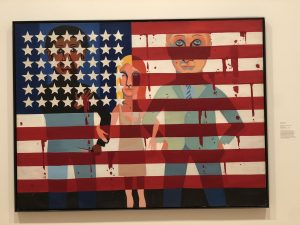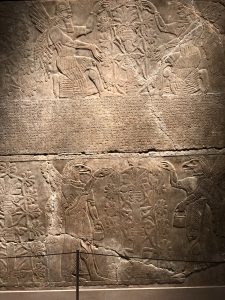PART 1
From the Ancient World exhibit in the Brooklyn Museum, I chose the “Bird Woman” figurine from the 37th Century B.C.E. Just by looking at this statue, there were a couple of details that stood out to me. For example, the face has a similar structure to a birds beak, and the arms are unusually long. They are gracefully up in the air and have the possibility of representing wings. At the tip of the arms, the hands seem to display fingerlike structures. The “Bird Woman” is a very unique piece because it incorporates both a womanlike anatomy and a birdlike. The color is of copper tone and seems to be made up of clay. Its figure is very curvy as if the expectations of a woman at that point in time was to look like that. The artist also included the breasts of a woman. The height of the figurine is no taller than the height of a coffee cup.
After exploring the exhibit, I wanted to learn more about the figurine. After some research, I found out that the bottom half of the figure is actually a representation of a long white skirt covering the legs of the woman. That is why it looks as if the woman has no lower half. It is still unknown to this day if the sculpture represents a goddess or a woman. I guess that part is up for interpretation.

PART 2
After the Ancient World exhibit, I got a chance to look at Brooklyn Museum’s Soul of a Nation exhibit. A lot of the pieces that I saw have some sort of political agenda, much of which relates to today’s current events. Even though these pieces were created around the 70’s, it’s quite sad how they can relate to problems in the world today. There is still a huge issue with oppression, discrimination, and inequality in our nation which should ultimately be fixed. I chose the piece known as “All Power to the People” by Faith Ringgold. This was an interesting choice for me because I noticed that at the bottom of the piece it says, “Free all political prisoners.” I pictured this as an art piece created in today’s society and the kind of response it would receive. Due to the fact that most of New York’s society is democratic, the response that this piece would get is a positive one.
When I saw the words “free all political prisoners,” I pictured a society oppressed by the government and their power plays. A society that has had enough with being used in politician’s games for power. A lot of people feel the same way today about the way the government acts. Another thing that was quite compelling is the color scheme of the piece. The background is red, the words are black, the figures are black, but the eyes and the clothing are green. Also, the guns are grey. The red background could symbolize the blood of the people and the black could symbolize the seriousness of the situation presented. The man, woman, and child all have a weapon of some sort colored grey. This symbolizes a revolution. However, the green clothing is quite a mystery. Only certain things are marked green but seems to me that it is random. Also, the lines that compose the figures of the man, woman, and child are not straight, but are curvy.

I found this exhibit to be refreshing in a way where even though it was in the past, it affects the future immensly. Art is the perfect way to express one’s self even if it is representing the vision of a whole society.











